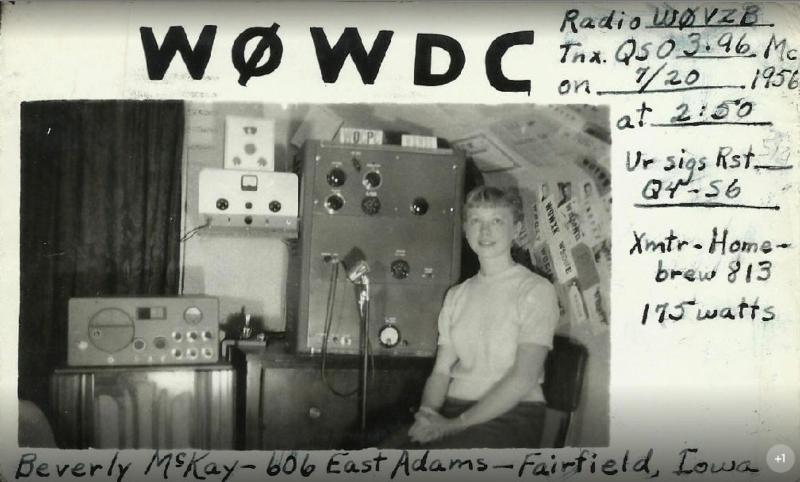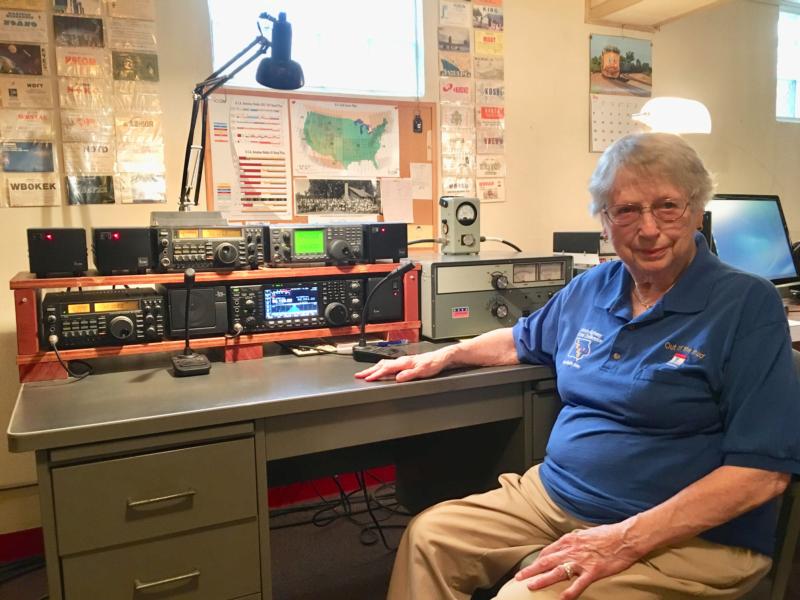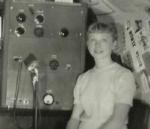
Posted By: Robert Nickels (ranickels) Posted: 12/11/2019 Historic 12/11/2019 |
65 Years as a YL HamBev Becker WØWDC |
|
This all started when I discovered a fantastic collection of vintage photo QSL cards on a Google+ site – I’d encourage every ham to spend some time looking through this amazing bit of history: https://plus.google.com/115747543308902188110 The photos capture a wide range of ham gear and stations from the spark era through the 70’s, and nearly every picture triggered my curiosity. But one was especially interesting because it showed an attractive YL posed with a classic AM station from the mid-50s, which I consider to be the “golden age” of ham radio. The photo was taken a few years before the space age really began to accelerate the interest in science and technology, and it was still the era when girls weren’t as often encouraged to get involved in technical hobbies, so I became curious and checked some vintage callbooks. To my surprise, I found that WØWDC was still licensed and living in Cedar Rapids, IA, where I have friends who might know her, which proved to be the case. I made contact with Bev and her husband Van WØVAN to ask their permission to submit this photo to Electric Radio, along with a few comments about Bev’s long-time involvement in ham radio. Since they wrote the story better than I ever could have, I’ll just pass it along verbatim. Congratulations to Bev, WØWDC, on 65 years in ham radio! “Older hams will recognize the Heathkit AT-1 transmitter and VF-1 VFO. The receiver is a Hallicrafters SX-43. The big box contains a homebrew AM transmitter with an amplifier with a single 813 final.When the QSL card was mailed in 1956, Bev was 17 years old and a freshman at Parson’s College in Fairfield, Iowa. Bev was first licensed in 1954 as WNØWDC. The new photo cards were a big improvement over the originals where she painted out the novice N with pink nail polish after she passed her general class license.Even in school, she was thinking ahead. She looked around and soon realized that unlike the football players, the smart boys were in the radio club.Her first husband was Frank, WØCPC. (He passed in 1982.) Her second husband, Van, WØVAN, first licensed in 1962, keeps the antennas up and the amplifier warm.Now, at 80 years old, Bev is still active with radio, but she balks at climbing the tower. She checks into the 75-meter (noon) traffic net often enough that the net control stations still remember her voice and name. She passes out a few contacts/points during the ARRL/UHF/VHF contests. Together with Van, she visits five or six ham fests a year in Iowa and Illinois. And, she is currently the president of NY2SF, the Lincoln Highway Amateur Radio Group. (NY2SF, “New York to San Francisco,” – the terminals of the great historic highway.Bev delights to point out to newbies that she had to hand-draw schematic diagrams of oscillators for her general test. She passed 13 words per minute in front of an FCC examiner at a federal building in Des Moines. As a new general class operator, she operated 11 meters CW before it was taken from us amateurs to form the citizen’s band. She claims that DX was great on 27 mc (in case you’ve forgotten, that’s now MHz.) Her fascination with high power amplifiers goes way back. She is always striving for a signal that to the listening operator sounds like someone “slapping a big fish on the side of the barn,” when the D-104 is squeezed.Yes, when we married in 1990, we did go to the Dayton, Ohio hamfest on our honeymoon. After years of teaching at private colleges, Bev finished her career and retired at age 75 from the Cedar Rapids, Iowa Police Department Detective Bureau.”
|
|
Related Images
Click on the image title or on the image itself to open the full-sized image in a separate window.Latest Articles
|
Crystal Replacement
Posted: 02/38/2024
Comments: 0 |
How good can a crummy receiver be?
Hundreds of different simple SDR receivers have been designed around Dan Tayloe's Quadrature Sampling Detector or QSD. Mine add nothing to the state of the art, and in fact subtract things, as I like minimalist solutions and the QSD is right in that sweet spot. Following the evolution of Tayloe's design I delete the resistors in series with the sample lines for inst... READ MORE |

Technical
Posted: 02/37/2024
Comments: 0 |
What's in a number (3253)?
The FST3253 dual four-to-one mux/demux IC has long been used as a "Tayloe Detector" or QSD (and QSE) in low-cost SDRs. They provide incredible performance for such a simple circuit, converting RF to baseband IQ with low loss and the ultimate in simplicity. Unfortunately the original FST3253 part has become obsolete and while substitutes are available, this is where the... READ MORE |

Vintage Ham Radio
Posted: 02/32/2024
Comments: 0 |
The Stancor 10P Transmitter
There weren't really many commercial transmitters in the 1930s as most hams built their own. But many of the ones that were offered came from the transformer companies who had two chances to profit. First, from those who would buy the kit, and two, from those would would see it in the (free) booklets the companies provided to their distributors who would then sell the iron to ham... READ MORE |

Vintage Ham Radio
Posted: 12/355/2023
Comments: 0 |
The Care and Feeding of the EF Johnson Courier amplifier
The EF Johnson "Courier" is a grid-driven amplifier using two 811A tubes. Switching is provided for operating in either class C for CW or as a class B linear amplifier for AM or SSB. Rated power is 500 watts input for CW, 500 watts PEP input for SSB, and 200 watts input for double-sideband AM with carrier. Since all amateur power levels were meas... READ MORE |

Historic
Posted: 11/329/2023
Comments: 0 |
TV Duplexer
Some things are interesting, even if totally useless nowadays. Such is the case with the Philco 426-3034 Crossover Kit for UHF TV. What the heck is that? Well, back in the late 50s, UHF television stations operating on channels 14-83 started to appear in many areas of the US where viewers had a VHF-only TV antenna, and in many cases an externa UHF converter was... READ MORE |

Crystal Replacement
Posted: 11/327/2023
Comments: 0 |
Replacing failed crystals
For decades, quartz crystals were used everywhere a stable frequency source was needed, even in some applications that depended on overtone (harmonic) behavior into the VHF range. These crystals were less stable and more dependent on circuit parameters that fundamental types and thus more problematic. Such was the case with the 94 MHz crystal in the 2 meter converter ... READ MORE |

Historic
Posted: 11/315/2023
Comments: 0 |
My Own Ham Radio Story by W9RAN
Everyone has a story of how they got involved in ham radio - this is mine. It started much earlier, including receiving a Knight Kit Span Master shortwave radio for Christmas in about 1963, at age 12. I'll never forget the night my dad and I finished building it and I wanted to try it out. It came with a 50 ft. antenna which was still coiled up - but ... READ MORE |

Technical
Posted: 09/267/2023
Comments: 0 |
Hot to simulate vacuum tubes in LTSpice
LTSice is a powerful simulation tool that is provided free by Linear Technology Corp. It comes with a complete library of passive and common analog solid-state components but if you want to use it to simulate vacuum tubes, it doesen't work as-is. Even though triode and pentode symbols can be found in the "Misc" folder, they are just schematic symbols and... READ MORE |
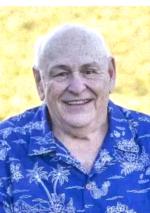
Friends Remembered
Posted: 07/208/2023
Comments: 0 |
Merv Schweigert, K9FD (SK)
Comments from Robert Nickels W9RAN, July 27, 2023: There is nothing worse for a ham radio operator than to see a beloved friends callsign with the letters "SK" behind them. Yet sadly, that's what happened on July 23, 2023, when I learned of the passsing of Merv Schweigert, K9FD. While many of our ham radio interests were different - Me... READ MORE |
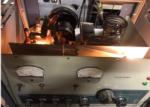
Vintage Ham Radio
Posted: 01/19/2023
Comments: 0 |
"Winter Projects"
I know many of us who enjoy restoring and repairing vintage gear look forward to winter when there is less competition for time and energy, and a chance to really make a dent in our "to be fixed" piles. A couple of years ago I set time aside for "Heathkit Singlebander Week" and went through every one of them I had, with the result that they're all working ... READ MORE |
